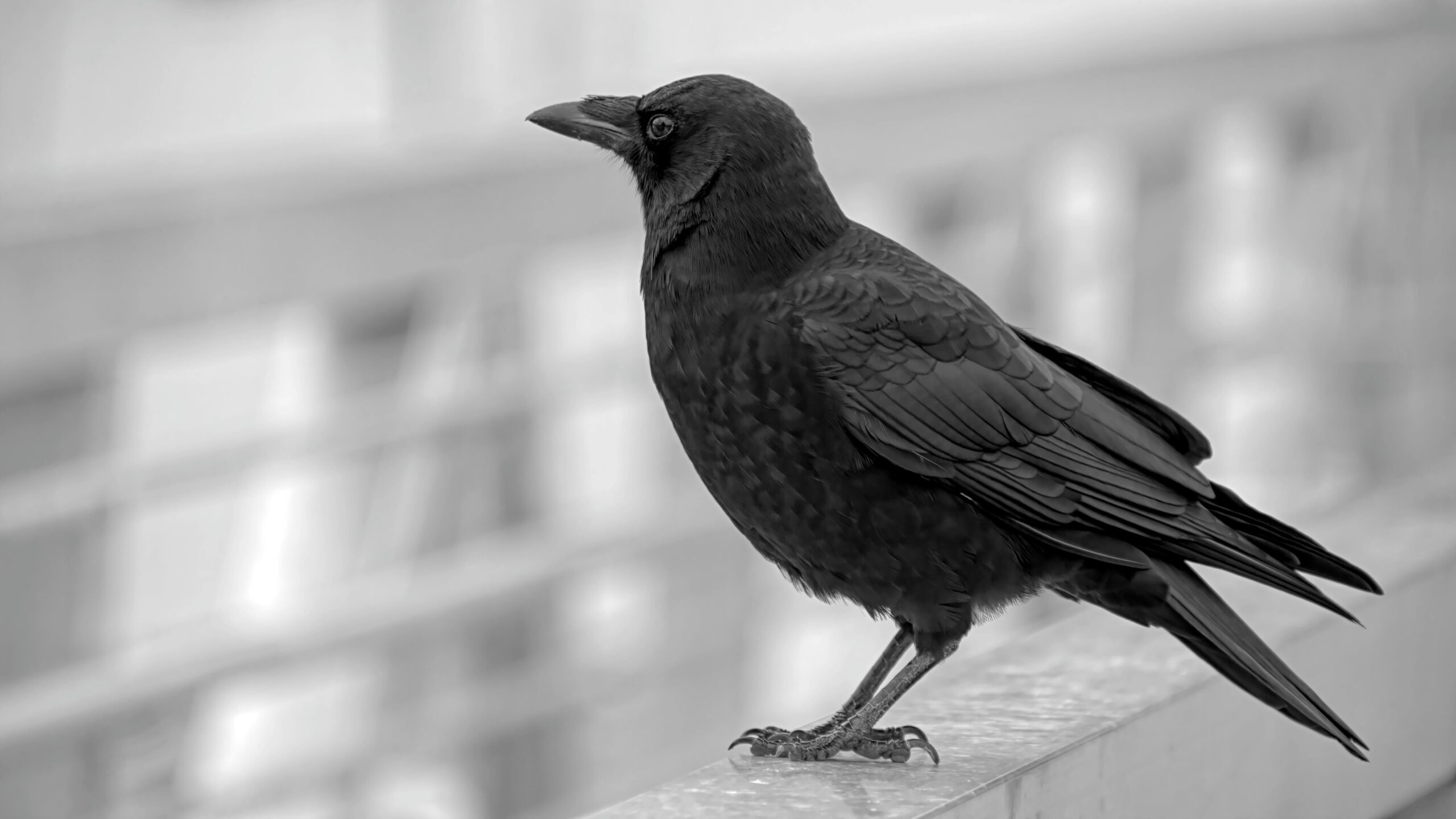The raven vs crow comparison often sparks curiosity due to their striking similarities, yet these birds are distinctly different in many aspects. Belonging to the Corvidae family, both ravens and crows are among the most intelligent avian species on the planet. However, key distinctions in appearance, behavior, and habitat set them apart in meaningful ways.
This article provides a detailed examination of raven vs crow differences — from size and vocalisation to social structure and geographical distribution. Whether you’re a birdwatcher, student, or simply intrigued by wildlife, understanding these differences will enhance your appreciation for two of nature’s most fascinating creatures.
Physical Differences Between Raven and Crow
When comparing raven vs crow, one of the most noticeable distinctions lies in their physical characteristics. While both birds feature glossy black feathers and similar silhouettes, several subtle and not-so-subtle differences help in accurate identification.
- Size: Ravens are significantly larger than crows. A typical raven has a wingspan of up to 4 feet, whereas a crow’s wingspan usually maxes out around 3 feet. Ravens also tend to have bulkier bodies and heavier bills.
- Tail Shape: In flight, a raven’s tail appears wedge-shaped, while a crow’s tail looks more fan-shaped.
- Feathers and Texture: Ravens often exhibit a shaggy appearance around their throat feathers, called “hackles,” whereas crows have smoother neck plumage.
- Beak Structure: Ravens possess a thicker, more curved beak that complements their larger size. Crows have a slimmer and straighter bill.
Recognizing these visual markers is essential for bird identification in the field and helps enthusiasts and researchers distinguish between these often-confused species.
Size, Feather Structure, and Beak Characteristics
The physical anatomy of these birds reflects their adaptation to different environments and lifestyles.
- Size Metrics: On average, a raven measures 24 to 27 inches in length, dwarfing the crow, which averages 17 to 21 inches. This size disparity can be a quick indicator in the wild.
- Feather Texture: Raven feathers have an iridescent quality and look slightly more disheveled, particularly around the neck area. These hackles are a key visual cue when viewed up close or through binoculars.
- Bill Morphology: A raven’s beak is not only more robust but also more arched at the tip. This adaptation aids in tearing food apart, reflecting their often more carnivorous diet compared to crows.
Understanding these traits allows observers to make more informed identifications and contributes to broader ecological studies on bird species and their evolution.
Behavioral Contrasts in Raven vs Crow
Behaviorally, the raven vs crow comparison reveals distinct patterns that go beyond physical appearance. These birds exhibit different levels of social behavior, problem-solving, and even playfulness—making them standout subjects in avian intelligence research.
- Social Structure: Crows are extremely social and are often seen in large flocks, especially in urban areas. Ravens, on the other hand, are more solitary or found in mated pairs.
- Flight Patterns: Ravens soar gracefully in the sky with occasional acrobatics, while crows have a more stable and direct flight path with consistent wingbeats.
- Tool Use: Both birds are known for using tools, but ravens show a broader variety of tool-based problem-solving, especially in experimental settings.
- Curiosity and Play: Ravens display more playful behaviors such as sliding on snow, aerial somersaults, or even playing games with each other—a sign of high cognitive function.
These behavioral traits not only set them apart but also reveal their unique ecological roles and adaptability in diverse environments.
Intelligence, Tool Use, and Communication
Ravens and crows are among the most intelligent birds on Earth, but their cognitive abilities express themselves in slightly different ways.
- Tool Usage: Crows, particularly the New Caledonian species, are famed for using sticks and even crafting tools. Ravens, although less observed in the wild using tools, perform better in controlled problem-solving tasks.
- Communication: Crows have a complex system of vocal calls used for coordination and warning. Ravens also have a rich vocal repertoire, but they include a variety of clicks, gurgles, and even mimicry.
- Problem-Solving: In laboratory studies, ravens have demonstrated advanced problem-solving and planning skills, such as bartering and delaying gratification, which rivals the intelligence of some primates.
These mental capabilities reinforce the importance of preserving both species for ongoing cognitive and behavioural research in birds.
Habitat and Range of Ravens and Crows
The raven vs crow comparison extends into their habitat preferences and geographical distribution, which can be useful indicators when trying to identify these birds in the wild. Although they may sometimes coexist in overlapping territories, their typical environments often differ significantly.
- Ravens are more likely to be found in remote, open landscapes such as mountains, forests, deserts, and tundra. They prefer less-populated areas and are more commonly spotted in wilderness regions across the Northern Hemisphere.
- Crows, in contrast, are highly adaptable and thrive in urban, suburban, and rural environments. Their ability to exploit human-altered landscapes gives them a wider presence in populated areas.
- Both species are found throughout North America, Europe, and parts of Asia, but the Common Raven (Corvus corax) has a more expansive range into harsh, less hospitable climates where crows are rarely seen.
Understanding where these birds typically reside helps in identifying them, especially for birdwatchers and researchers working in field environments.
Preferred Environments and Geographic Spread
When evaluating habitat use, both ravens and crows show remarkable adaptability, but their preferences hint at different ecological niches.
- Crows are opportunists. They are often seen near highways, cities, agricultural fields, and even garbage dumps—any place where food is readily accessible. Their presence is closely tied to human activity.
- Ravens, though also opportunistic feeders, avoid heavily populated regions. They’re frequently found in national parks, remote forests, and mountainous zones where they build large stick nests on cliffs or tall trees.
- In terms of altitude, ravens often nest and forage at higher elevations, while crows are more common at lower, human-dominated elevations.
These patterns highlight the role of human influence in shaping crow distribution while underlining the raven’s preference for seclusion and open space.
Vocalisation Differences in Raven vs Crow
One of the most distinctive and practical ways to tell raven vs crow apart is through their vocalizations. Both birds are known for their wide range of sounds, but their calls differ significantly in tone, pattern, and purpose.
- Crows typically emit a sharp, repetitive “caw” that is loud and piercing. This call is often used for alerting other crows of danger, marking territory, or gathering in groups.
- Ravens, on the other hand, have a deeper, throatier, and more resonant “croak” or “gronk” sound. Their calls can also include a variety of clicks, rattles, and even mimicked noises from their surroundings.
- These vocal differences can often be heard even before the birds are seen, making sound a useful field identification tool.
Because both species are highly vocal and communicative, their calls reflect their intelligence, social structures, and adaptation to their environments.
Calls, Sounds, and Vocal Patterns
The vocal complexity of these birds goes far beyond simple calls.
- Crow Calls: Their “caw” is not just one call; it varies in rhythm and pitch depending on context. Studies show crows use different alarm calls for different predators and even change calls based on location and situation.
- Raven Vocalizations: Ravens exhibit a broader vocal range, including imitations of other animals, water dripping, and even human-made noises. This mimicry ability is especially pronounced in captive or human-exposed ravens.
- Communication Functionality: Both species use their calls not just for warnings or territory defense, but also for bonding, play, and information sharing within their groups.
These acoustic signals are a testament to the birds’ high intelligence and adaptability, offering a non-visual way to distinguish between them in the field.
Lifespan and Social Structure
Another key area of difference in the raven vs crow comparison is their lifespan and social behavior. While both species are intelligent and adaptable, their social dynamics and longevity vary, influencing how they interact with their environment and one another.
- Lifespan: Ravens generally live longer than crows. In the wild, ravens can live up to 15–20 years, with some documented cases exceeding 40 years in captivity. Crows typically live around 7–10 years in the wild but may reach 20 years under human care.
- Social Behavior: Crows are known for forming large, tight-knit communities and often roost in groups numbering in the thousands, especially in urban areas. This collective behavior aids in survival and resource sharing.
- Ravens, by contrast, are more solitary or monogamous, often forming long-term pair bonds. They may forage alone or in small family units, especially during breeding season.
These differences reflect broader variations in their life strategies, from family dynamics to community living.
Mating, Flock Behavior, and Longevity
Exploring their reproductive and social tendencies reveals how ravens and crows differ on a deeper behavioral level.
- Mating Systems: Both species are monogamous, but ravens are particularly known for forming lifelong bonds. They often engage in courtship displays involving aerial acrobatics and synchronized flight.
- Flock Formation: Crows regularly form large communal roosts, especially outside of breeding season. These roosts offer safety in numbers and enhanced communication. Ravens do not typically form such massive groups.
- Parental Investment: Both species show high parental care, but raven parents tend to be more territorial and secretive about nesting.
- Longevity Factors: The raven’s longer lifespan may be linked to its more isolated lifestyle and lower exposure to urban threats, while the crow’s shorter life expectancy could relate to increased contact with vehicles, toxins, and predators in populated environments.
These differences offer further insights into how evolution, ecology, and social organization shape each species’ survival.
Conclusion: Decoding Raven vs Crow Differences
Understanding the nuances in the raven vs crow comparison provides not only clarity in identification but also a deeper appreciation for two of nature’s most intelligent birds. From distinct physical traits like size and feather texture to contrasting behaviors, habitats, and vocalizations, ravens and crows demonstrate unique adaptations that help them thrive in different environments.
While crows often dominate urban settings with their social flocks and sharp calls, ravens rule the wilder landscapes with solitary grace and complex vocal mimicry. These differences reflect how each species has evolved to fit its ecological niche while maintaining a shared legacy of intelligence and adaptability.
Whether you’re an amateur birdwatcher or a dedicated naturalist, recognizing the differences between raven vs crow adds a valuable layer to understanding avian life and biodiversity.
FAQs
How can you tell the difference between a raven and a crow?
Answer: Ravens are larger, have wedge-shaped tails, and make deep, croaking calls. Crows are smaller, with fan-shaped tails and sharp “caw” sounds.
Do ravens and crows live in the same areas?
Answer: Yes, their ranges overlap, but ravens prefer remote, wild habitats while crows thrive in urban and suburban environments.
Which bird is smarter, the raven or the crow?
Answer: Both are highly intelligent, but studies show ravens may have an edge in problem-solving and planning, while crows excel at tool use.
Are ravens and crows part of the same species?
Answer: No, they are different species within the Corvidae family. Ravens belong to Corvus corax, while crows include several species like Corvus brachyrhynchos.
Why are crows more common in cities than ravens?
Answer: Crows adapt well to human environments and food sources, while ravens prefer solitude and less-populated, natural areas.

